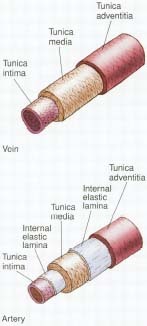Varicose Veins
Varicose veins are veins that become stretched, enlarged, or twisted. They can often be seen on the legs, just below the surface of the skin, and they may give legs a lumpy appearance.
KEYWORDS
for searching the Internet and other reference sources
Circulatory system
Vascular system
What Are Veins and Arteries?
The body has two systems for carrying blood to and from all its cells, tissues, and organs. Arteries carry blood from the heart to the organs, and veins return blood back to the heart. Although veins and arteries are similar in structure, veins usually carry blood with less oxygen than arteries do, and vein walls are thinner and weaker than arterial walls. When veins become injured or empty, they sometimes dilate * or collapse and become varicose
Where Do People Get Varicose Veins?
Varicose veins develop on the inside areas of the leg or on the back of the calf. The veins look bluish in color and may become swollen, which gives the leg a lumpy appearance. About 15 percent of adults in the United States develop varicose veins. Women sometimes develop vari-cose veins during pregnancy and develop them more often than men do. There is a tendency for varicose veins to run in families.
What Is the Treatment for Varicose Veins?
Many people with varicose veins have no symptoms, but some people feel pain in their legs, especially when they stand for long periods of time.
Mild cases
In mild cases, doctors usually suggest that people with varicose veins exercise to improve circulation and that they wear support hose or stockings around the swollen veins to help relieve pain. People with varicose veins are usually told to sit with their feet up as often as possible and to avoid standing for prolonged periods of time.
Severe cases
When people have more severe cases of varicose veins, doctors sometimes inject a solution into the vein to block it. The body then reroutes the blocked vein's blood supply to nearby veins that are healthier. Sometimes doctors "strip" varicose veins, which means they remove them surgically. This process takes about 30 minutes and is often quite successful.
* dilate (DY-late) means to become enlarged or stretched beyond the usual boundaries.
* varix, varices, varicose are the Latin words that describe veins, arteries, or lymph vessels that have become stretched or enlarged.

Resource
The U.S. National Institutes of Health (NIH) has a search engine at its
website that locates information about varicose veins at the U.S.
National Heart, Lung, and Blood Institute (NHLBI) and elsewhere.
http://www.nih.gov
Comment about this article, ask questions, or add new information about this topic: